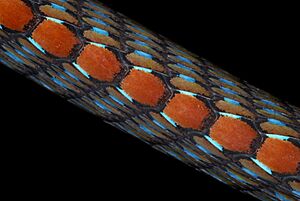Wall's bronzeback facts for kids
Quick facts for kids Wall's bronzeback |
|
|---|---|
 |
|
| Dendrelaphis cyanochloris | |
| Conservation status | |
| Scientific classification | |
| Genus: |
Dendrelaphis
|
| Species: |
cyanochloris
|
| Synonyms | |
|
|
The Wall's bronzeback (Dendrelaphis cyanochloris), also called the blue bronzeback, is a type of snake. It belongs to a group of snakes known as colubrids. You can find this snake in parts of Southeast Asia.
Contents
What Kind of Snake Is It?
Understanding the Wall's Bronzeback's Family Tree
The Wall's bronzeback snake is part of a larger group of snakes called Dendrelaphis. This group has about 48 other types of snakes. The Wall's bronzeback is very similar to another snake called Dendrelaphis ngansonensis. They might even be part of a "species complex," which means they are very closely related.
The Dendrelaphis group is one of five main groups in the Ahaetuliinae family. These are often called "vine snakes." Dendrelaphis snakes are most closely related to Chrysopelea snakes, also known as "flying snakes."
Where Does the Wall's Bronzeback Live?
Finding the Wall's Bronzeback's Home
This snake lives in several countries. You can find it in India (in areas like Assam, Arunachal Pradesh, and the Andaman Islands). It also lives in Bangladesh, Myanmar, southern Thailand, and western Malaysia. It might even live in Bhutan.
The Wall's bronzeback mostly lives in trees. It prefers thick, old rainforests that are not too high up, usually below 1,000 meters (about 3,300 feet) in altitude.
How Does the Wall's Bronzeback Behave?
Daily Life and Reproduction of the Wall's Bronzeback
Just like other bronzeback snakes, this one is active during the day. This means it is diurnal. It spends all its time in trees, making it fully arboreal. When it comes to having babies, the Wall's bronzeback lays eggs. This is called oviparous reproduction.
Is the Wall's Bronzeback Safe?
Protecting the Wall's Bronzeback's Habitat
The Wall's bronzeback is quite common and can be found in many places. Because of this, the IUCN (International Union for Conservation of Nature) lists it as a "Least Concern" species. This means it is not currently in danger of disappearing.
However, its home is still at risk in some areas. This is mainly due to habitat loss. Forests are sometimes cut down for agricultural expansion (to make more farms) or for logging (to get wood). These activities can harm the snake's living areas.



